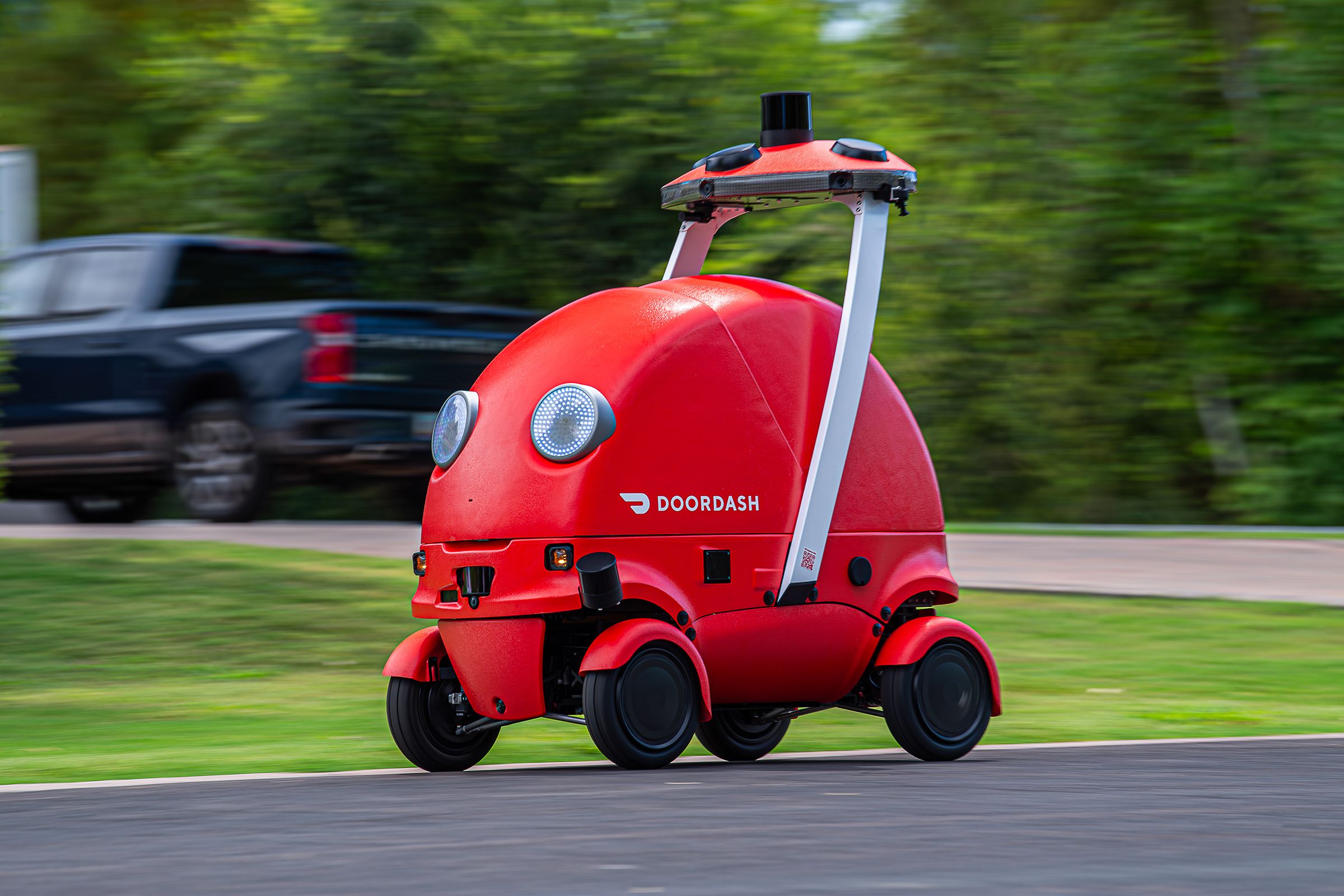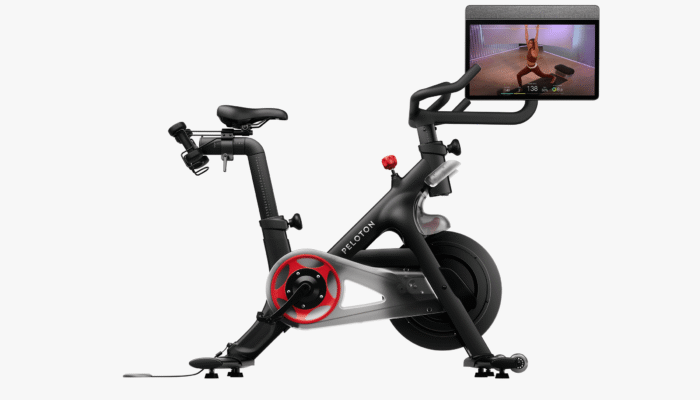When we first got close to Dot, DoorDash’s new delivery robot, we looked right into its big blue, pixelated eyes and gave it a kick. A little one. A tap, really.
It’s not WIRED’s policy to be mean to 350-pound hunks of plastic on wheels. But it’s a big, cruel world out there, and delivery robots like Dot will have to face—are already facing, because Dot has just started doing deliveries in metro Phoenix—myriad dangers and challenges.
So many challenges, in fact, that although companies are making big strides in autonomous vehicles—two more companies launched public rides in the US just this month—delivery robots like Dot have followed a rockier road.

A fleet of Dots.
Courtesy of Doordash
DoorDash showed off the nearly 5-foot-tall robot, studded with cameras and sensors, at an event in San Francisco on Monday. The company says the vehicles are built to travel up to 20 mph on roads, bike lanes, and sidewalks, and can carry up to 30 pounds of cargo—a bunch of pizzas, a mountain of pad thai, or a small grocery order. The vehicle is electric, has a swappable battery, and can travel up to six miles per charge.
DoorDash cofounder and DoorDash Labs head Stanley Tang emphasized that the company plans to pursue a “hybrid” model for deliveries going forward—working with human Dashers but also drones and autonomous vehicles. (The company also introduced on Monday a new “Autonomous Delivery Platform” that can dispatch orders between all three.) “We definitely want to get this to as many places as we can,” Tang said about Dot. “We’re trying our hardest.”

The Dot is packed with sensors to help it find its way in the world.
Courtesy of Doordash
App-based companies have publicly spoken for years about the money-saving potential of autonomous vehicles. These firms have poured billions of dollars into recruiting and managing the independent contractors who do the delivering and driving for them, and millions more ensuring they’ll stay independent contractors and not employees. What if the firms could skip all that? What if robots did all the work, or at least some of it?
Still, with today’s announcement, DoorDash is throwing its lot into an industry that has faced some choppy waters. And, of course, the threat of public kicks.
Speed Bumps
Delivery robots were hyped during the onset of the Covid pandemic as a solution to that other very human problem of contagion. Since then, however, Amazon and FedEx abandoned their delivery robot projects; others working on delivery bots have pivoted to software or industrial uses. The companies that remain have mostly focused on smaller deployments on college campuses or a select few cities, and those don’t seem to be growing as quickly as hoped.
Estonian company Starship Technologies, the biggest one still standing in the delivery robot space, has found a niche operating on mostly university campuses, where streets and sidewalks are wide, well-maintained, and relatively friendly, and where those desperately seeking 2 am pizzas and burritos are at their least price-sensitive. Postmates spinoff Serve Robotics launched in 2017 but has built only 400 robots, according to its most recent financial flings, with goals to build 2,000 by the end of the year.
Contrast that with the growth in autonomous vehicles. Though robotaxi services are still limited to a handful of global cities, they’re picking up and dropping off customers to the tune of hundreds of thousands of rides per week.
The reason for the slower growth in delivery robots is actually pretty simple, says Bern Grush, the executive director of the nonprofit Urban Robotics Foundation: “You’re trying to solve a much harder problem with far, far, far less capital and far, far, far less compute.”
Consider the technical challenge Dot has ahead of it: DoorDash says the robot is built to operate on sidewalks, bike lanes, and roads. It’s meant to pilot in and out of parking lots to pick up food and to navigate driveways and apartment complexes to drop it off. That means the software needs to “understand,” predict the movement of, and get around a remarkable number of situations, vehicles, and living things: cars, trucks, school buses, strollers, children’s bicycles, aggressive mopeds, motorized wheelchairs, dogs, squirrels, toddlers, people with limps, runners, competitive cyclists. And on and on.

Each Dot can carry 30 pounds of cargo, drive up to 20 mph, and go about six miles on a charge.
Courtesy of Doordash
Delivery robots face “all the challenges of the real world,” says Nikolas Martelaro, an assistant professor at the Human-Computer Interaction Institute at Carnegie Mellon University. In 2021, he and colleague Sarah Fox followed around a small test fleet of delivery robots in Pittsburgh, Pennsylvania. “They had trouble navigating sidewalks, they got stuck, they had interactions with people that were not always ideal,” he says. Just this month, he noted, a video of a motorized wheelchair user trying and failing to get around a sidewalk delivery robot in Los Angeles went viral, echoing a similar incident that happened when the bots were testing in Pittsburgh. “They’re still sort of unsolved problems,” Martelaro says.
Beep Beep
Still, DoorDash executives say the company has built something that’s robust enough to last on the streets and cute enough to look like a good neighbor. (In their research, Martelaro and Fox did observe a good Samaritan helping a stuck robot out of a planter. It’s possible to build something that everyone doesn’t want to kick.) Big googly eyes on the front act as headlights and expressive lenses. Push a button and the hull peels back like a big gaping mouth to reveal the delivery sitting inside. There are cup holders for drinks and temperature-controlled sections for different types of food. On the outside, DoorDash’s designers even gave Dot a little speck of a nose, for maximum anthropomorphization.
Dot is big for a delivery vehicle; standing next to it, it feels like a slightly smaller Smart car. Tang says the size and heft should discourage people from messing with it. “It’s harder to pick up than a sidewalk robot,” he says.

Restaurant workers drop the order in and close the lid.
Doordash’s New Delivery Robot
DoorDash isn’t sharing many details about how Dot’s “early access” deliveries in Arizona are going; executives wouldn’t say how many Dots exist, how many orders they’ve completed, how many restaurants are working with Dot, or where Dot will go next. (“We’re rapidly adding robots to meet the demand we’re seeing while Dot is in early access,” spokesperson Mattie Magdovitz says in an email.) They wouldn’t say how much money they’re investing in Dot or how big the team working on Dot is, though Tang noted that the company has a “world-class autonomy program with world-class talent.”
Dot’s success may be determined not by how its performance compares with other robots but by how it compares to humans. Sucharita Kodali, a retail analyst with market research firm Forrester, says that customers like app-based delivery because of the convenience—and because it means someone drops off their goods exactly where they want them. But Dot, and other delivery bots, don’t climb stairs or open doors or gently place a carton of eggs on the porch. “Why are we trying to get sidewalk robots that nobody asked for?” Kodali says.
Dot is heading out onto the sidewalks and into the bike lanes of the world regardless, where it will face all manner of hurdles and harassment. At the end of the DoorDash event, we asked if we could kick Dot again, for real this time, to test out how robust it was. A bigger one anyway, the sort of kick the bot might receive in an interaction with an annoyed cyclist, a frustrated wheelchair user, or a distracted driver. The DoorDash PR rep said we had to wrap. Ashu Rege, DoorDash Labs’ head of autonomy, fixed us with a plaintive look.
“Please don’t kick my robot,” he said.
Update, September 30 at noon: This story was updated to correct an error in citing Dot’s mileage. It can travel up to six miles on a full battery.




